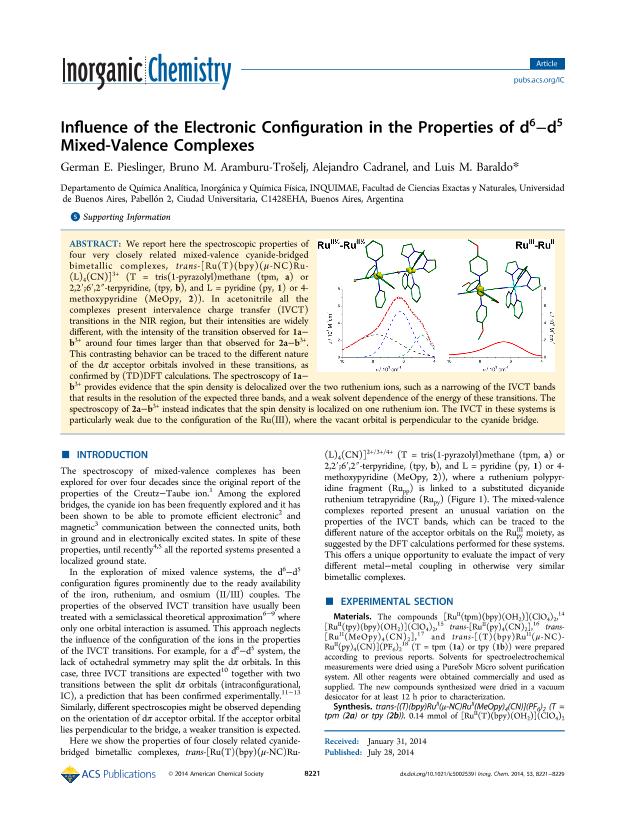Artículo
Influence of the Electronic Configuration in the Properties of d6–d5 Mixed-Valence Complexes
Pieslinger, German Eduardo ; Aramburu Troselj, Bruno Martín
; Aramburu Troselj, Bruno Martín ; Cadranel, Alejandro
; Cadranel, Alejandro ; Baraldo Victorica, Luis Mario
; Baraldo Victorica, Luis Mario
 ; Aramburu Troselj, Bruno Martín
; Aramburu Troselj, Bruno Martín ; Cadranel, Alejandro
; Cadranel, Alejandro ; Baraldo Victorica, Luis Mario
; Baraldo Victorica, Luis Mario
Fecha de publicación:
07/2014
Editorial:
American Chemical Society
Revista:
Inorganic Chemistry
ISSN:
0020-1669
Idioma:
Inglés
Tipo de recurso:
Artículo publicado
Clasificación temática:
Resumen
We report here the spectroscopic properties of four very closely related mixed-valence cyanide-bridged bimetallic complexes, trans-[Ru(T)(bpy)(μ-NC)Ru(L)4(CN)]3+ (T = tris(1-pyrazolyl)methane (tpm, a) or 2,2′;6′,2″-terpyridine, (tpy, b), and L = pyridine (py, 1) or 4-methoxypyridine (MeOpy, 2)). In acetonitrile all the complexes present intervalence charge transfer (IVCT) transitions in the NIR region, but their intensities are widely different, with the intensity of the transition observed for 1a–b3+ around four times larger than that observed for 2a–b3+. This contrasting behavior can be traced to the different nature of the dπ acceptor orbitals involved in these transitions, as confirmed by (TD)DFT calculations. The spectroscopy of 1a–b3+ provides evidence that the spin density is delocalized over the two ruthenium ions, such as a narrowing of the IVCT bands that results in the resolution of the expected three bands, and a weak solvent dependence of the energy of these transitions. The spectroscopy of 2a–b3+ instead indicates that the spin density is localized on one ruthenium ion. The IVCT in these systems is particularly weak due to the configuration of the Ru(III), where the vacant orbital is perpendicular to the cyanide bridge.
Archivos asociados
Licencia
Identificadores
Colecciones
Articulos(INQUIMAE)
Articulos de INST.D/QUIM FIS D/L MATERIALES MEDIOAMB Y ENERGIA
Articulos de INST.D/QUIM FIS D/L MATERIALES MEDIOAMB Y ENERGIA
Citación
Baraldo Victorica, Luis Mario; Cadranel, Alejandro; Aramburu Troselj, Bruno Martín; Pieslinger, German Eduardo; Influence of the Electronic Configuration in the Properties of d6–d5 Mixed-Valence Complexes; American Chemical Society; Inorganic Chemistry; 53; 16; 7-2014; 8221-8229
Compartir
Altmétricas



